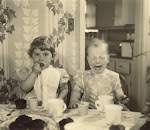Party on Russet Lane about 1950 with Chris R. on the left,
maybe Maureen, then John R. and one of the Harrisons.
We were often reminded when we were very young how lucky we were to have sugar.
Cele feeding her cranky new baby (me) a few months after the War.
Appropriate food was not easy to buy as much was still rationed.
My mother was a big fan of Jell-O. Because it's composed primarily of sugar, Jell-O was one of the sweet things unavailable after sugar supplies were cut off by the Japanese invasion of Manila. Once it was back in the stores we ate a lot of it.
If we didn't clean our salad plates we were reminded that we should be grateful just to have that wiggly treat. I guess because it could be green, Jell-O was considered a salad. In certain parts of the Great Plains it is still a salad bar feature.
Poster from 1946
Meat was rationed because it was shipped overseas. In New York City, Mayor LaGuardia declared meatless Tuesdays and meatless Fridays. Meatless Fridays wouldn't have been much of a hardship for Catholic girls but cooks of that generation had a hard time coming up with vegetarian dishes. My mother's old stand-by of creamed salmon on toast with canned peas would have been tough because canned goods of any kind were scarce due to metal rationing in manufacturing.
Ration book and stamps
I remember a few ration books in the back of the "junk drawer" in the kitchen into the 1950s. Housewives had coupons and stamps to be used for meat, butter, sugar, coffee and canned goods. I imagine the coupon books were saved because they were so valuable during the War that people couldn't bring themselves to throw them out....ever.
Bacon Grease Cannister
My mother saved bacon grease in old coffee cans.
During the War it was patriotic to take the cans to the butcher who sent them to the government to be recycled for weapons. (How---I do not want to know.) And shortening of any kind was difficult to get.
I stored used bacon grease in cans well into the 1970s until one day I realized you didn't need to keep a can of bacon grease. You could just throw the grease away after you cooked the bacon. Just put it in the trash. (I still feel guilty although the house smells better.)
Cele and Ben and their friends the Hetricks in Barnegat on the Jersey Shore, May, 1944
Separates and rayon dresses were the effects of rationing.
War-time regulations dictated how much yardage could be in clothing. Any waste of fabric from patch pockets to cuffed pants was forbidden. No one item could have more than a certain amount of fabric, so short skirts became popular and so did separates. Blouses and skirt combinations became the fashion as manufacturers figured out ways to get around the cloth restrictions.
May, 1943
Even Grandma's skirts got shorter.
The McNallys on a visit to Jack at military camp.
Silk and nylon were needed for parachutes so women began wearing rayon. Rayon was made of small fragments of cotton formed into long strands using a kind of mucilage. Cele told us about a rayon dress she wore into the city one day. It started to rain and her dress started to shrink and dissolve as the mucilage decomposed in the water. She was always a little wary of rayon. (Fashion alert: Rayon is more durable today.)
Rayons in the 1943 Montgomery Ward's catalog











































